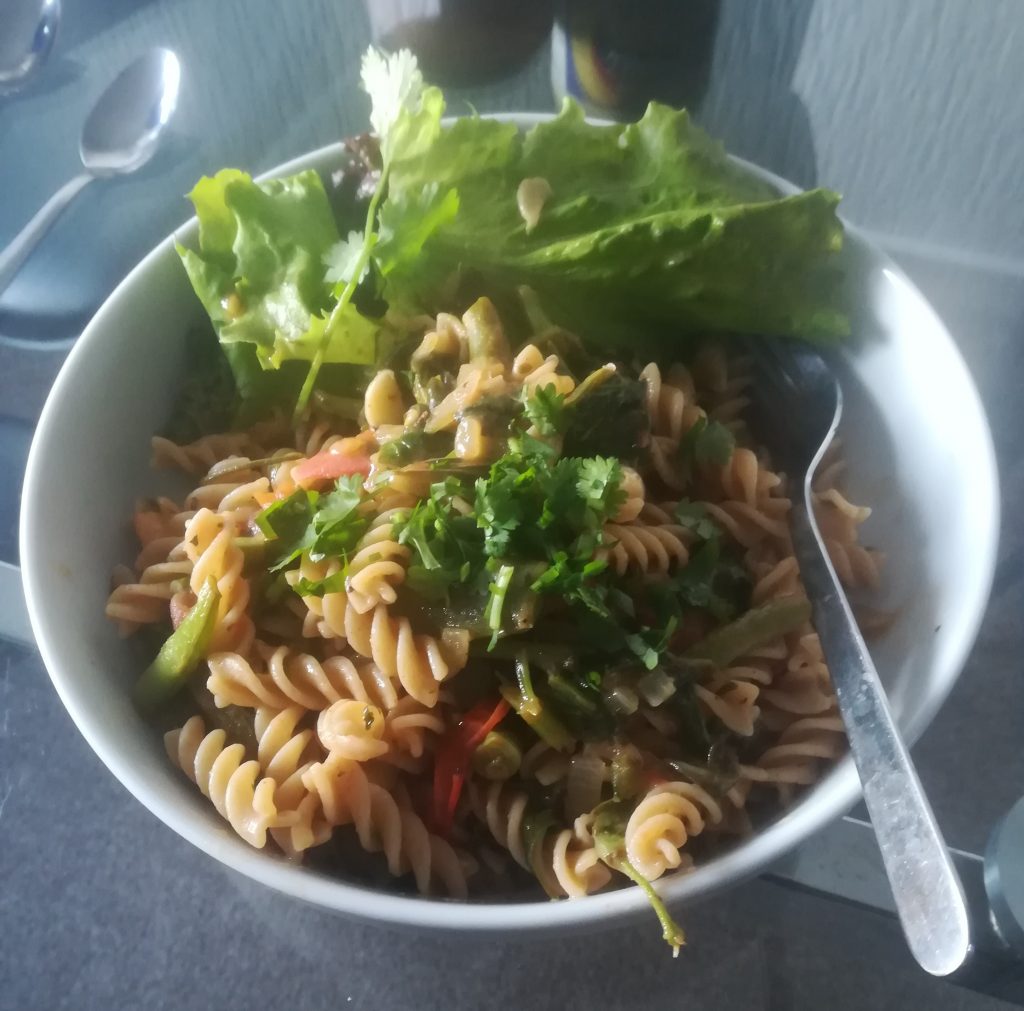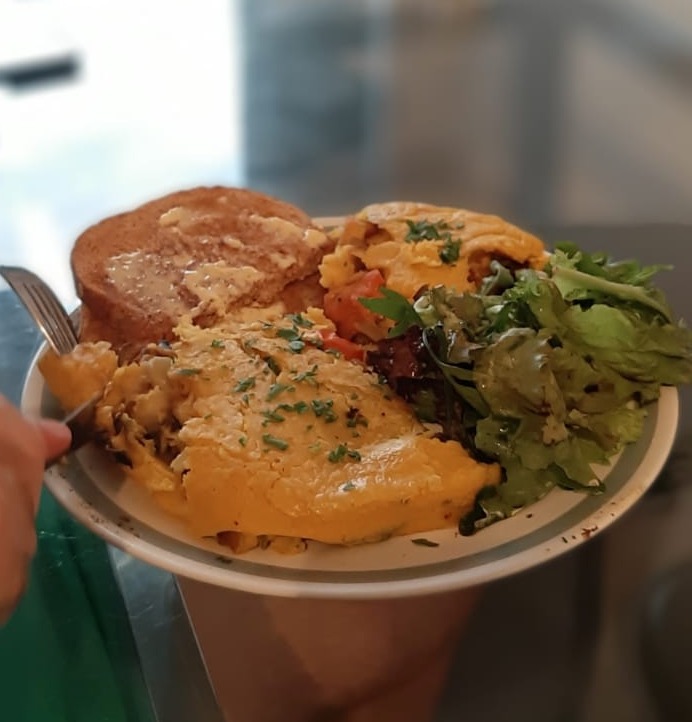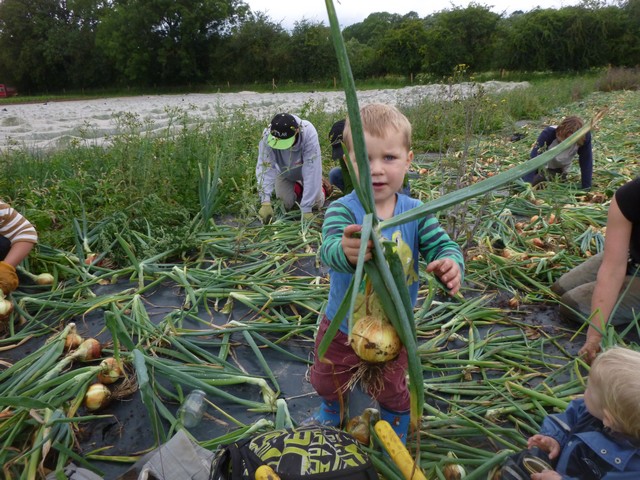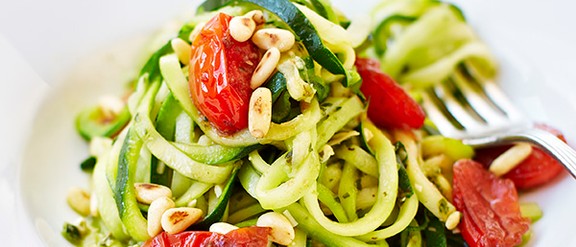Rob’s Recipe of the Week: Road trip pasta
This week I’m keeping it simple and taking a little inspiration from a recent roadtrip to Italy. The spinach and tomato are pretty core to the dish but feel free to pick and choose from the rest of the list depending what you’ve got – I use an app called plant jammer to figure out what things might go well together.

Core Ingredients (for 1 person):
Pasta of your choice, 2 handfuls
Fresh Tomatoes, 1 large handful
Spinach (or other greens depending on share), 3 handfuls
Basil, small handful
Garlic, 1 clove
Lemon Juice 0.5-1 tablespoon or to taste
Olive Oil, 2-3 tablespoons or to taste
Mixed herbs, 1 teaspoon
Optional extras:
Black olives, small handful
Walnuts, small handful
Onion, 1 medium
Green/French Beans, about 3cm bundle
Method:
First chop all your veg; tomatoes into quarters, spinach may need stems chopping down to manageable size, garlic minced or thin slices, onion diced
Next get the pasta on the boil – when it’s ready remember to keep the water!
Whilst the pasta cooks, fry off onion and garlic, then add tomatoes, spinach and any optional extras and fry at a medium heat.
The pasta should be ready about the same time as the veg is cooked. Before draining, add the olive oil to the veg and then add a few sloshes of the pasta water – the starch helps make a good sauce! Then add the lemon juice, basil and mixed herbs and stir it all together until you have a nice shiny consistent sauce. Season with salt and pepper.
Drain the Pasta and add to the pan, mix and serve with some salad on the side and a little chopped coriander on top.
Rebecca’s Recipe of the Week: Fried Aubergine Slices
Meltingly tender circles of fried aubergine make an excellent nibble, and a spicy accompaniment to any meal. The recipe below gives the amount for one small Canalside aubergine, but is easily scaled up. I’ve never had any left over, but Madhur Jaffrey says they’re good warmed up the next day.
Fried Aubergine Slices
Ingredients
1 Canalside aubergine
1 teaspoon salt
½ teaspoon turmeric
¼ teaspoon cayenne pepper, or ½ a Canalside dried chile (seeds removed if you prefer), chopped fine
Freshly-ground black pepper
Vegetable oil, for shallow frying
½ lemon wedge, to serve
Preparation
Cut the aubergine into slices about 1cm thick.
Mix together the salt, turmeric, cayenne or chile and black pepper in bowl.
Toss the aubergine with the mixed spices.
Heat about ½cm oil in a frying pan over medium heat. When it’s hot put in as many aubergine slices as will fit comfortably in a single layer. Don’t crowd the pan or they won’t fry properly. Fry until reddish-brown on the bottom. Flip and fry the other side.
Remove them as they are done, onto some kitchen paper or a cloth, and fry the remainder. Add more oil if necessary.
Serve with a squeeze of lemon.
Recipe adapted from Madhur Jaffrey, Indian Cooking (2002).
Rob’s Recipe of the Week: Vegan ‘omelette’ for filling
I picked up this recipe whilst living in Gothenburg and it has great connotations for me with sunny breakfasts on the pier… Hopefully I don’t just see it with rose tinted glasses!

Vegan chickpea flour (kikärtsmjöl) omelette
Ingredients
1 cup (120 g) chickpea flour
1 Tablespoon flaxseed meal or chia seed meal (optional)
1/2 tsp (0.5 tsp) salt
1/4 tsp (0.25 tsp) each of turmeric garlic powder, baking soda, cumin powder
1ish cup of waterFillings!
Fried tomato, onion, mushrooms, lots coming in our shares that could suit!
Method is simple, mix the all the dry ingredients then add the water slowly and mix with a whisk until they take on the same consistency as whisked eggs. Fry up the fillings, then poor on the omelette mix and reduce pan to a medium to low heat. Make sure you cook it slower and longer than an egg omelette – it tends to burn before solidifying enough to flip if you rush it.
Rebecca’s Recipe of the Week: Buckwheat dosa with coconut chutney and greens
Rebecca’s Recipe of the Week: Buckwheat dosa with coconut chutney and greens
Another easy and delicious recipe from Meera Sodha. She writes: ‘This dish consists of three separate elements: the dosa batter, the coconut chutney and the vegetable filling. . . The key to success is to make [the dosas] in a nonstick pan on a very high heat – it needs to be very hot indeed – and make sure you leave them to crisp up properly before even thinking about flipping them with a spatula. The first pancake will inevitably fail – such is the universal law of pancakes – so make it a small one, so as not to waste too much batter’.
Buckwheat dosa with coconut chutney and greens
Serves 3
Ingredients
100g desiccated coconut
Salt
180g buckwheat flour
6 tbsp oil, plus extra for brushing
12 fresh curry leaves
1 tablespoon cumin seeds
1 tablespoon black mustard seeds
3 garlic cloves, peeled and minced
2cm ginger, peeled and grated
1-2 green chillies, finely chopped (or to taste)
400g chard or spinach, leaves shredded, tough stalks roughly chopped
200g frozen peas
Preparation
Put the desiccated coconut in a heatproof bowl with a third of a teaspoon of salt, cover with 275ml boiling water and leave to soak for at least 30 minutes.
Meanwhile, put the buckwheat flour in another bowl with half a teaspoon of salt. Slowly pour in 450ml water, mix to a thin batter, then set aside.
Put the oil in a nonstick frying pan and get it really hot, then add the curry leaves, cumin, mustard seeds, garlic, ginger and chillies, and fry for two to three minutes, until the garlic turns a pale gold. Carefully tip into a jug to cool. Keep the pan for later.
When the spiced oil has cooled, stir two tablespoons into the coconut mix, and another two tablespoons into the buckwheat batter. Tip the coconut into a blender and blitz until really smooth (add a little more water, if need be).
Reheat the frying pan over a high heat and, when hot, add the rest of the spiced oil, followed by the chard or spinach stalks. Fry, stirring, for three minutes, then add the leaves and cook until wilted. Throw in the peas, cook for a couple of minutes, until everything is nice and hot, then stir through a couple of tablespoons of the coconut chutney. Scrape out into a serving dish, wipe the pan clean with kitchen paper and put back on the heat.
Once the pan is really hot, brush the surface with a fine layer of oil. Add a small ladleful of batter and swirl it into a thin layer – a few gaps and bubbles are fine, because they can help the dosa get crisp. Cook the dosa for two minutes, until the edges are visibly crisp and browning, then gently lever up with a spatula, flip and cook for a further two minutes on the other side, before turning it out on to a plate. Repeat with the remaining batter, oiling the pan between each dosa.
Stuff the dosas with the greens and serve with the remaining chutney on the side.
Recipe adapted from Meera Sodha, The Guardian, 13 July 2019.
2019 – August news: Mid-Season Stocktake
Now we’ve harvested a decent proportion of our maincrop potatoes, the growers are able to calculate the expected total yield with reasonable accuracy, and we are pleased to report an excellent crop (probably) with approximately 8 tonnes left in the grounds and a year-total of 10 tonnes. Assuming nothing disastrous happens (a dangerous thing to assume!) this should give you a sizeable potato share every week until mid-spring 2020. So we’ll certainly be busy on Potato Day, 14th September, and as always will welcome all comers to lend a hand.
The onions also look good with a crop of around 1500kg.

Rob’s Recipe of the Week: Dinner on the run
I went to a very interesting sports food recovery workshop with a nutritionist called “whole food warrior” whilst at a running festival earlier in the summer. This is one of her recipes which should be pretty quick and simple, enjoy!
Chickpea, green bean & spinach curry (15-minute recipe)
Ingredients (feeds 2)
For the curry paste:
A handful of fresh coriander, stalks & leaves (10-15g)
1/2 green pepper (75g), roughly chopped
1 red chilli, roughly chopped
1/2 thumb size piece of ginger (15g), peeled and roughly chopped
1 small onion (55g), peeled and roughly chopped
1 turmeric root or 1/4 teaspoon of turmeric powder
1/2 lemon, peeled (you are using the actual lemon here, not the rind)
1 teaspoon of cumin seeds
1/2 teaspoon of cinnamon
sea salt and freshly ground black pepper
Other ingredients:
150g of dwarf beans or green beans
1 tin of chickpeas
1/2 a tin of chopped tomatoes (200ml)
1/2 a tin of coconut milk (200ml)
4 large handfuls of spinach (approximately 120g)
Method:
Put all of the curry paste ingredients in a blender, season with a pinch of sea salt and some freshly ground black pepper and blend until smooth. Add a splash of water to make the bending easier if needed.
Put a frying pan on a medium high heat. Tip in the curry paste and cook until it thickens to a paste, approximately 5 minutes.
Pour in the chopped tomatoes and coconut milk, stir well, season with a little bit more sea salt and black pepper.
Add the green beans and cook for 5 minutes.
Tip in the chickpeas and spinach and cook for a further 5 minutes until the sauce has thickened.
Check the taste and season with more black pepper and sea salt if needed.
To serve, simply divide the curry between two large bowls. Sprinkle on some extra coriander leaves if desired.
Taken from: https://wholefoodwarrior.co.uk/blog/quickcurry
16th aug
Rebecca’s Recipe of the Week: Green Beans, Tomatoes and Saffron
Serve this lovely blend of tomatoes, beans and saffron-scented onions as a side dish, or alongside some polenta topped with a poached egg. It’s also tasty accompanying plain white fish.
Fagiolini in umido all zafferano
Serves 4 as a side dish.
Ingredients
10 medium tomatoes
60ml olive oil
2 medium onions, peeled and thinly sliced
1 small pinch of saffron
650g green beans, topped and tailed
Preparation
Bring a medium pot of water to the boil. Prepare a bowl of ice water.
Score the bottom of each tomato with a X, using a sharp knife, and remove the core. Drop the tomatoes into the boiling water a few at a time, and cook for about 30 seconds each, until the skin starts to loosen. Remove with a slotted spoon and drop into the bowl of ice water. Don’t discard the hot water: you’ll use it to cook the beans.
Fish each tomato out of the ice water and slip off the skin. Dice into small cubes.
Put the olive oil and sliced onions into a saucepan over very low heat. Add a pinch of salt and the saffron. Cook gently for 20-25 minutes, or until the onions are soft and translucent. Stir occasionally and make sure they don’t catch or burn.
Add the diced tomatoes and cook for 10 more minutes. Season with salt.
Bring the tomato water to a boil, salt, and cook the beans for 6 minutes, or until tender. Drain the beans and add to the onion-saffron-tomatoes. Simmer for 3 more minutes over low heat and serve.
Recipe adapted from Christopher Boswell and Elena Goldblatt, Verdure: Vegetable Recipes from the American Academy in Rome (2014).
Rebecca’s Recipe of the Week: Green Beans, Tomatoes and Saffron
Serve this lovely blend of tomatoes, beans and saffron-scented onions as a side dish, or alongside some polenta topped with a poached egg. It’s also tasty accompanying plain white fish.
Fagiolini in umido all zafferano
Serves 4 as a side dish.
Ingredients
10 medium tomatoes
60ml olive oil
2 medium onions, peeled and thinly sliced
1 small pinch of saffron
650g green beans, topped and tailed
Preparation
Bring a medium pot of water to the boil. Prepare a bowl of ice water.
Score the bottom of each tomato with a X, using a sharp knife, and remove the core. Drop the tomatoes into the boiling water a few at a time, and cook for about 30 seconds each, until the skin starts to loosen. Remove with a slotted spoon and drop into the bowl of ice water. Don’t discard the hot water: you’ll use it to cook the beans.
Fish each tomato out of the ice water and slip off the skin. Dice into small cubes.
Put the olive oil and sliced onions into a saucepan over very low heat. Add a pinch of salt and the saffron. Cook gently for 20-25 minutes, or until the onions are soft and translucent. Stir occasionally and make sure they don’t catch or burn.
Add the diced tomatoes and cook for 10 more minutes. Season with salt.
Bring the tomato water to a boil, salt, and cook the beans for 6 minutes, or until tender. Drain the beans and add to the onion-saffron-tomatoes. Simmer for 3 more minutes over low heat and serve.
Recipe adapted from Christopher Boswell and Elena Goldblatt, Verdure: Vegetable Recipes from the American Academy in Rome (2014).
Rob’s Recipe of the Week: For the last of the broad beans
If you’re a Saturday collector, you’ll be getting the last of the broad beans – why not try them in this recipe?!
I’ve had this recipe waiting in the sidelines for a while, expecting it to take ages but it turned out to be super easy! The fritters turned out pretty tastey and all that veg helped make me feel a little better about the deep fat frying… The recipe I got this from has instructions for homemade labneh, but I swapped that for lemon minted yoghurt. Since I had the frier out I decided to go all out and make courgette fritters, deep fried brie and onion rings as well, not a healthy night! Note the recipe is scalable for smaller shares but i’d keep the spice measures fairly high to avoid them getting lost in the frier.
Chilli broad bean fritters with homemade labneh
Ingredients:
Fritters:
600g broad beans (or 1¼kg in their pods), skinned to reduce bitterness (I didn’t bother and can’t say I noticed)
small bunch mint, roughly chopped
small bunch parsley, roughly chopped
small bunch dill, roughly chopped
1 tbsp self-raising flour, plus a little for dusting
1 red chilli (deseeded if you don’t like it too hot), roughly chopped
zest 1 lemon
2 small garlic cloves
1 tsp ground cumin
1 tsp ground coriander
½ tsp ground allspice
½ tsp sumac
Yoghurt:
1/4 a bunch of fresh mint , (7.5g)
1/2 lemon, (juice and any remaining zest after fritters)
4 tablespoons natural yoghurt (Alpro-style alternative will work great too)
Method:
Fritters:
To make the fritters, put the ingredients in a food processor, season and blend until smooth. Using 2 dessertspoons, scoop and shape the mixture into 16 quenelle shapes – or roll with floured hands. Place on a plate and chill for at least 1 hr, or cover loosely with cling film and chill for 24 hrs. (I chilled in freezer for 1h, they weren’t quite sticky enough but I managed by squeezing them hard with my hands).
When you’re ready to serve, heat at least 6cm oil in a wide, deep pan (or put a deep fat frier on 190°C). The oil is ready when a piece of bread dropped into the oil sizzles and turns brown within 30-40 secs (if the oil is too cool, the fritters will fall apart). Dust the fritters with a little flour and roll around the plate to coat the outside. Carefully lower 4-6 into the pan at a time and cook in batches, for 5-6 mins, until deep golden brown. Drain on a plate lined with kitchen paper and sprinkle with salt. Put the fritters in the oven on low heat while you cook the next batch.
Yoghurt:
Mix yoghurt, mint and lemon, adding salt and pepper to taste.
If you fancy them, courgette fritters or onion rings just need some batter making up in a bowl, about 50/50 self-raising flour (to get good bubbly batter) and water to a pancake batter consistency, add salt and pepper (and dill if you like) for a better taste. Chop courgette into sticks and onion into rings, rub them in a plate of flour (coat fully) then dip in the batter then into the frier. Fry until golden (1-3 minutes) then remove and drain, making sure to add salt and pepper whilst they’re fresh out of the frier! (This makes a BIG difference).
From: https://www.bbcgoodfood.com/recipes/chilli-broad-bean-fritters-homemade-labneh
Rebecca’s Recipe of the Week: Spring Onions and Tahini
It seems a pity to discard the flavoursome green leaves from a Canalside spring onion. This punchy blend of spring onion and tahini puts them to good use. It makes a great dressing for a spinach salad, coating the leaves in a savoury, creamy blanket. You could also use it as a dip.
Spring Onion and Tahini Blanket
Enough to dress a large 2-person salad
Ingredients
4 spring onions, including the green bits
2 tablespoons tahini
2 tablespoons rapeseed oil
2 tablespoons lemon juice
2 tablespoons water
Salt and pepper, to taste
Preparation
Roughly chop the spring onions.
Place everything in a blender, Nutribullet, or the container for an immersion blender. Blend everything until smooth. Check to see if it needs more salt, pepper, or lemon juice. If it’s too thick for your liking you can add a little more water to thin it out, and then serve either as a salad dressing, or as a dip.
Rob’s Recipe of the Week: Courgetti – why notti?
I’ve never tried this but my girlfriend assures me it’s a great summer recipe and a slightly different way to make use of courgette!

Courgetti with pesto and balsamic tomatoes
Ingredients
baby plum tomatoes 8, 4 halved and 4 whole
olive oil
garlic 1/2 clove, crushed
balsamic vinegar 1 tbsp
courgette 1 large, spiralised or very thinly shredded into noodles
fresh vegetarian pesto 2 tbsp
pine nuts 1 tbsp, toasted
Method
STEP 1: Toss the tomatoes with 1 tsp oil, garlic and balsamic vinegar and some seasoning. Tip into a frying pan and cook for 5 minutes until the whole tomatoes start to burst and they are coated in the balsamic.
STEP 2: Pour a kettle of hot water over the courgette spaghetti and blanch for 30 seconds. Drain really well, toss with the pesto and season well. Stir, coating the noodles, then add the tomatoes and toasted pine nuts to serve your courgetti.
From Olive Magazine